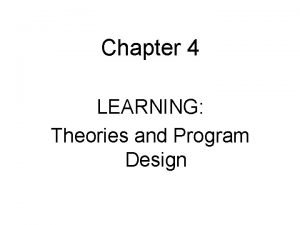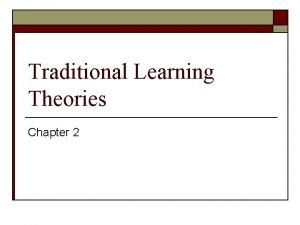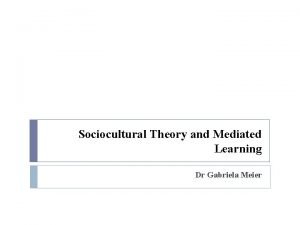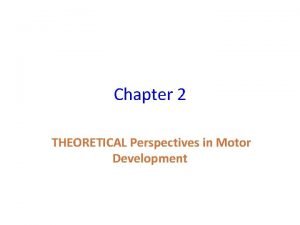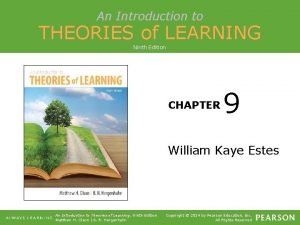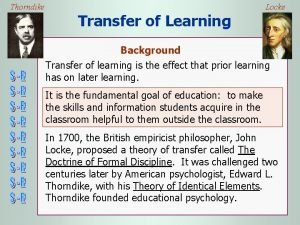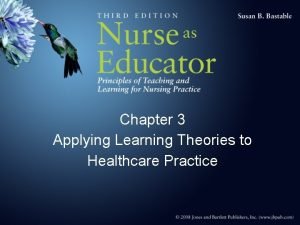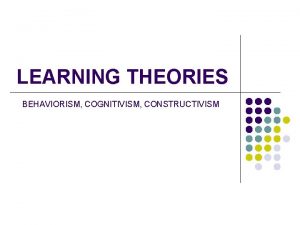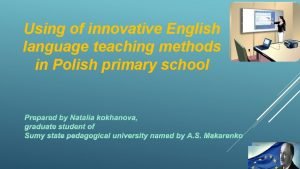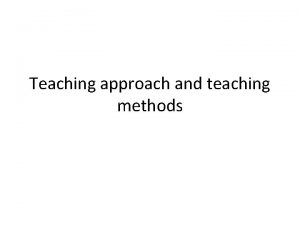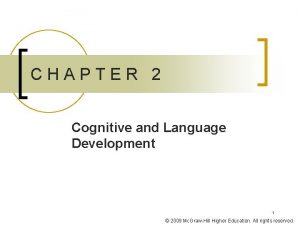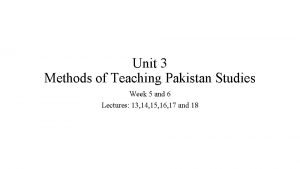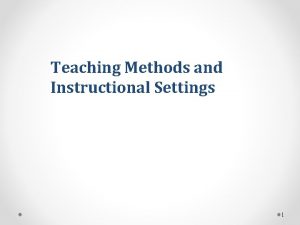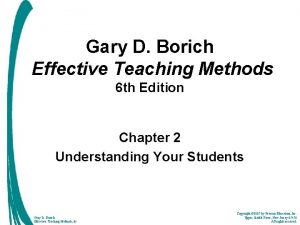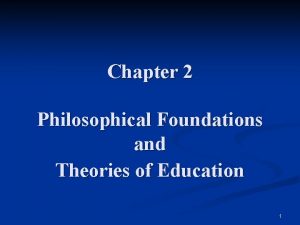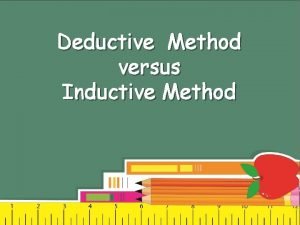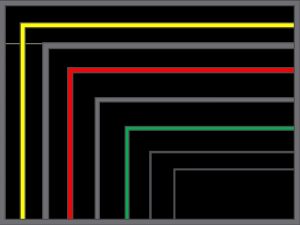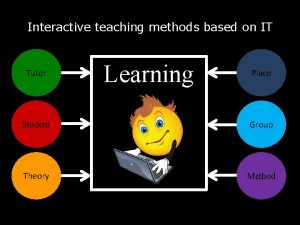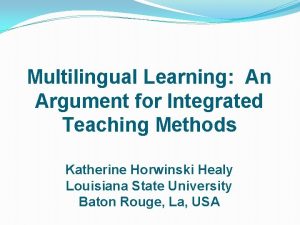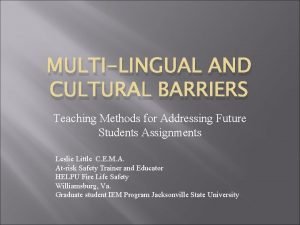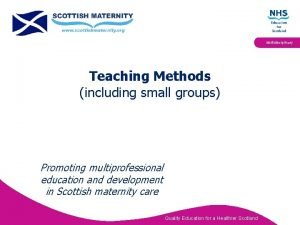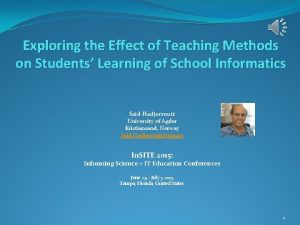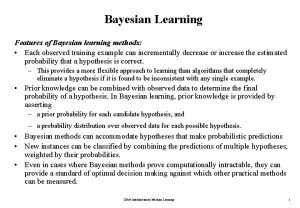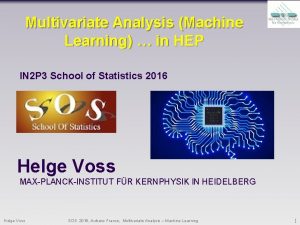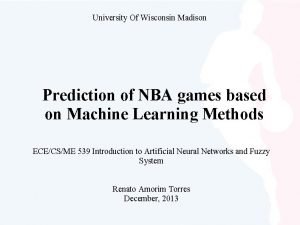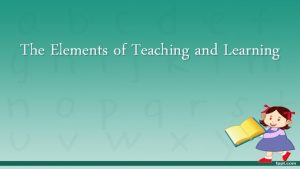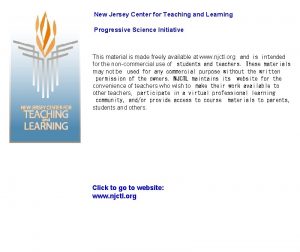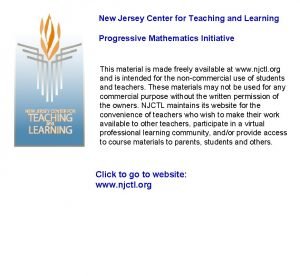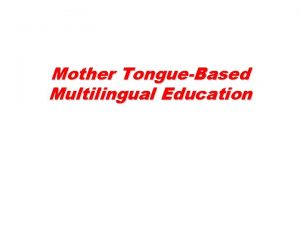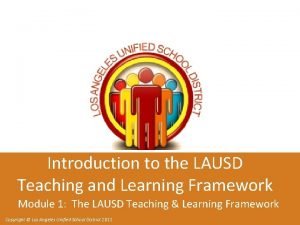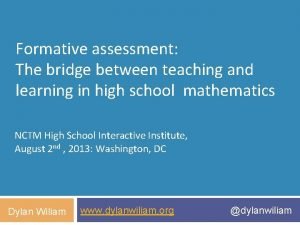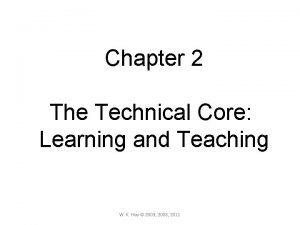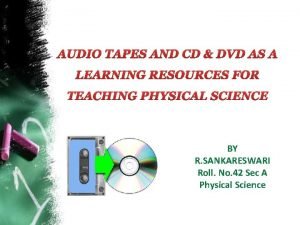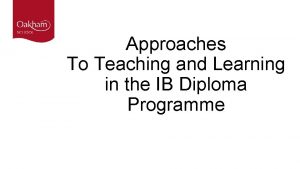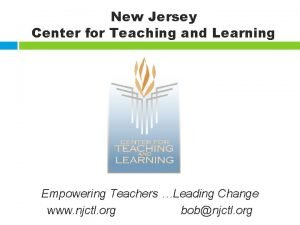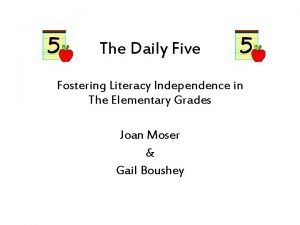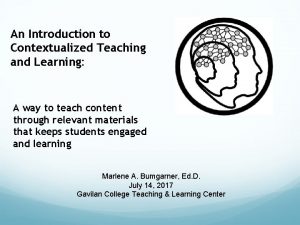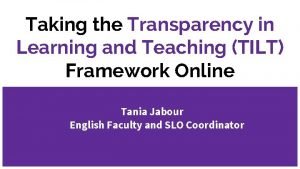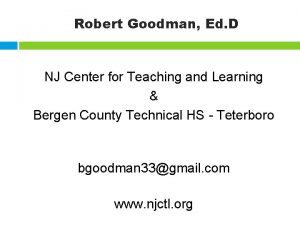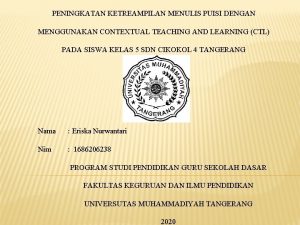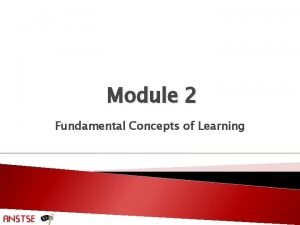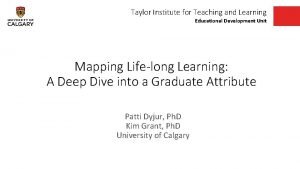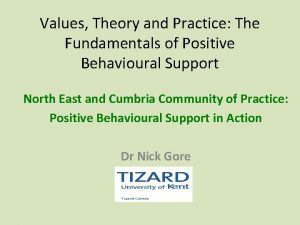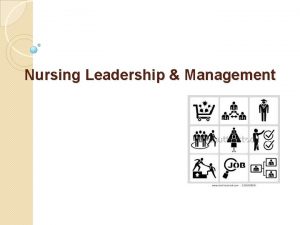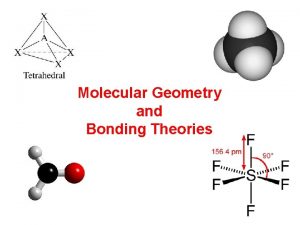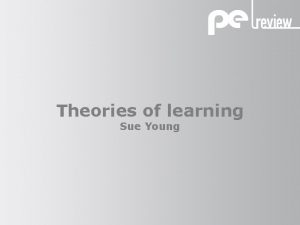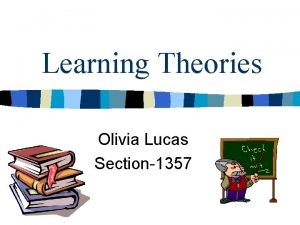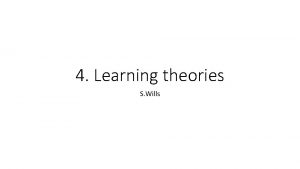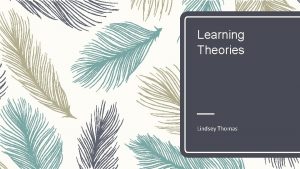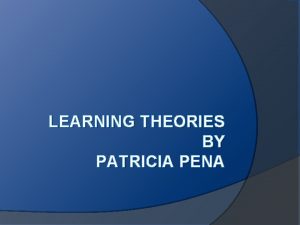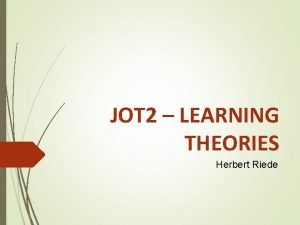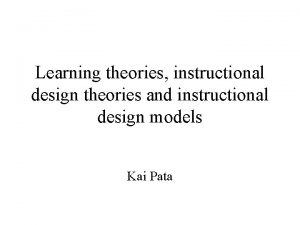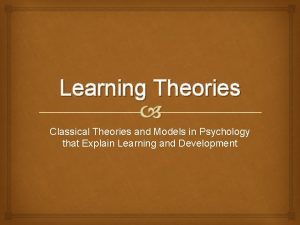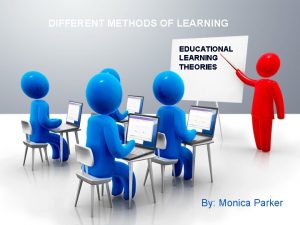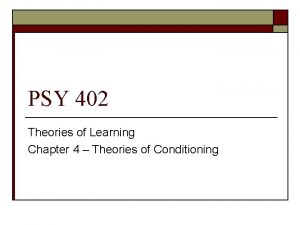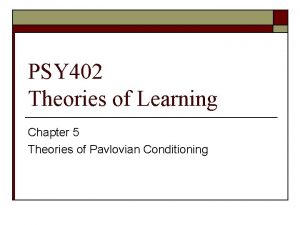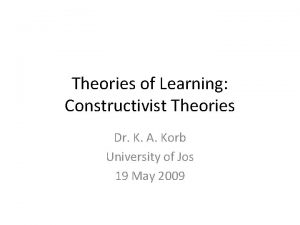TEACHING METHODS Theories of Teaching Teaching and learning


























































- Slides: 58

TEACHING METHODS

Theories of Teaching • Teaching and learning are some time thought to mean the same things. • They don’t… • The actual meaning of teaching and learning is negotiated between the person who act as “teacher” and those considered as “learners”

Theories of teaching • Teaching can be viewed from different perspectives as described by Miller Ø Assume students as a mere recipient Ø Knowledge is transmitted Ø Learner considered as an empty vassel to be filled with values, norms, knowledge and skills Ø Best methods fro teaching religion, cultural vaues

• Teaching as interaction/ transactional process • C S Ø Assume students participation and contribution during learning process Ø Knowledge is generated during the transaction process Ø Involves ( interaction, participation, active learning, facilitating, lecturer, discussion, questioning. Ø Plenary discussion, group discussion, discussion in pairs, seminars, panel discussions, debates etc

• Teaching as transformation process • • C S Ø Assume that during the teaching process, learners and content interact in such a way as to transform the students belief system and attitudes. Ø The keen students is also capable of transforming either content or teacher or both Ø This can be done through field visits, inviting key speakers of the field Ø A very important aspect of transformation is giving students feed back after they have done their work

THEORIES OF LEARNING

TEACHING METHODS • Methods of teaching a) Problem solving methods b) Project c) Field study d) Lecture methods e) Questioning methods f) Case study g) Brainstorming method

Selected learning theorists • 1. Behavioral theories • 2. Cognitive theories • 3. Social learning theories

Behavioral theories • View learning as a change of behaviors resulting form specific learning experiences • If a learner is able to do something they were not able to do before the learning, then learning has taken place

Behavioral Theory • Note the contribution of Thorndike, Pavlov, Skinner, Bandura on issues such as • Trail and error in learning, • Role of reinforcement, • Modeling • Repetition

Cognitive Theory • Consider learning as a manipulation or changes of mental process (cognitive structures)

• Emphasis: • Meaning full learning instead of rote learning • Proper sequencing and organization of ideas • Establishing right content at a right time(age sensitive) • See: Sheyer and Adey 1979, Adey (1988)

• Cognitive structure increases systematically as you grow up: • Sensori-motor Stage • Preoperational Stage • Concrete Operational Stage • Formal Operational Stage

Stages of human development • CS Changes by either the process of: • Assimilation: Assimilation adding new knowledge to the existing concept structure • Accommodation: Accommodation Re arranging Existing concept structure to fit the new knowledge

• When Do we learn more WHILE doing or AFTER doing?

Constructivism • Using learner’s own ideas in teaching and learning • Or enabling them to test their own theories or belief in a safe environment (in group or friend) might influence learning

• Personal Constructivism: knowledge is personal, you create it you die with it. See Kelly G. (1955) Psychology of personal construct • Social Constructivism: How society around us build a series of beliefs which are negotiated as correct and ideal: Schutz (1932) • Multiple Intelligent Theory: Howard Garner. People are born with multiple abilities

• As teachers and Instructors what do we learn from these theories?

Implications of learning theories in teaching • Understanding theories of learning should help teachers to design course delivery that facilitates learning • Teachers should aim at fostering learning environments where students know how to learn and how to think and reason • Integration of all these theories ensure a holistic approach to teaching and learning

TEACHING METHODS a) Problem solving method is the method in which students solve a problem using the scientific approach to collect and analyse data. This is the one among the best method of teaching students.

Steps Used in PSM. i) Identification of the Problem: A Teacher should state a problem to students which need immediate solution. Or should ask a question to be answered through investigation. ii) Hypotheses formulation: Is a predictive statement that relate to a problem.

Steps Used in PSM. iii) Collection of information about the problem The plan for investigation should be done which can be either in primary source or secondary sources or both. iv) Analysis of the problem After the completion of data collection all information should be analysed through different statistical methods to reveal the reality.

Steps Used in PSM. iv) Testing of the hypothesis: A teacher should guide the learner to test the hypothesis that have been developed earlier. Hypothesis can be either rejected or accepted by the findings. v) Generalization: Lastly the class make the general view about the prblm.

ADV. OF PSM i. Students are actively involved ii. Self learning tendency is developed to learners iii. Encourage critical thinking and scientific investigation iv. Gifted students are the most benefited through this method v. It involves cognitive of higher levels vi. Interest in learning and motivation are increased.

Limitations of PSM i. Time consuming ii. It is not possible to use for all situations iii. Sometime it is expensive iv. Slow learners may be at a disadvantageous group.

PROJECT METHOD Project is one among the common methods of teaching in schools. It is a natural, life like learning activity. The profounder of this method is John Dewey an American Philosopher.

PROJECT METHOD This method implies that the students should be educated in the manner they lives in the society.

GUIDELINE FOR USING PROJECT METHOD • The teacher has to consider the following: i. The alternative method to teach the topic ii. The available resources iii. The activities design for the topic should sustain the student interest. iv. To divide students into groups v. Arrange the class to the extent that students do not disturb one another.

Guideline cont……………. . v) The resource materials should be easily accessible vi) Teacher should be equally accessible to all students. vii) Student should be free to ask for help viii) The student findings should be complied and reported ix) The teacher should be a guide and a resource

ADV. OF PROJECT METHOD i. iii. iv. v. The students are fully involved in the project It is students centered It encourage learning by doing The students make school work real to life Encourage good cooperation among the students vi. Enhance self reliance vii. Students get accumulated knowledge about the topic

Limitations of Project Method i. Time consuming ii. It is expensive, it requires many resources. iii. It may be a problem to schedule a project as it may disrupt the school time table. iv. Its success depends on how well school is resourceful

DISCUSSION METHOD This method is the most appropriate in teaching topics that involve facts and opinions, topics that require flow of information and ideas from teacher to pupils, from pupils to teacher or from pupil to pupil.

HOW TO USE DISCUSSION METHOD i. A teacher must familiarize himself with the discussion topic ii. Sufficient learning activities must be planned for according to the features of the discussion. iii. A topic should be introduced very specific and well-defined familiar terms to students.

HOW TO USE DISCUSSION METHOD iv) Teachers role during discussion is a moderator or director of clarifying concepts, making tentative summaries, stating conclusion and keep discussion on track. v) Teacher should pass one group to another to visualize the discussion.

HOW TO USE DISCUSSION METHOD vi) The teacher should encourage many pupils to participate by directing some guideline questions. vii) An atmosphere of acceptance must exist in the classroom to the extent that students feel free to speak openly.

HOW TO USE DISCUSSION METHOD viii) When discussion is over the teacher should invite questions from the pupils

ADV. OF DISCUSSION METHOD i. Motivate and arouse interest and curiosity among pupils. ii. Promote team work. iii. Develop abilities of analysis and positive attitudes among students. iv. Develop questioning skills and responses to students v. It provide a direct feedback to the teacher on the understanding of the students on the topic

LIMITATIONS OF DISCUSSION METHOD i. Time consuming ii. Some students become passive while a few may tend to dominate the class ( group Shapers) iii. Pupils lose self-composure, get too emotionally involved and let matters get completely out of hand.

LIMITATIONS OF DISCUSSION METHOD i. Difficult to evaluate students ii. Silence may lead the teacher to take over the class in pursuit of the topic and thus may become a lecture iii. Teacher may get to frustration if the discussion fail to conclusion

FIELD STUDY This is the outdoor education technique which can be effectively used to deliver a lesson to students. During field study students go to places where relevant concepts and information may be observed and studied directly in their functional setting.

GUIDELINE FOR A SUCCESSFULFIELD STUDY i. A teacher should survey a content in the syllabus ii. A teacher should make a survey of the selected area: to have permission and to note points of observation iii. A teacher should discuss a scope of the field study: Should identify and carefully specify tasks to be pressed both in the field and in the classroom when the field work is over

GUIDELINE FOR A SUCCESSFULFIELD STUDY iv) The listing and collection of materials The teacher should help his/her pupils to point out and specify appropriate methods, materials and equipments that they will use during field work.

GUIDELINE FOR A SUCCESSFULFIELD STUDY v) Data collection in the field The teacher’s role should be a supervisor and helper to make sure all students are where they are supposed to be, make thorough observations at suitable points and record their observation relevant to the topic.

GUIDELINE FOR A SUCCESSFULFIELD STUDY vi) The analysis, interpretation and presentation of the data collected during the field. Upon the return to the classroom, groups should be organized to analyze and discuss the collected information from the field. Numerical data collected should be summarized classified and presented in the form of tables and graphs.

GUIDELINE FOR A SUCCESSFULFIELD STUDY vii) The display of findings and initiation of further discussion. The report sample and photographs of the studied area should be displayed in order to motivate and create interest among other pupils.

ADV. OF FIELD STUDY i. It provides first hand experiences to students which can serve as a basis for other learning activities. ii. Pupils become more aware of their environment iii. It develop to students skill of observation, ability of arguing, attitudes for listening and evaluating skills.

ADV. OF FIELD STUDY iv) It extends classroom learning in to reality. v) It can greatly add enhance the schoolcommunity relationship

THE LIMITATIONS OF FIELD STUDY i. If the method is not properly planned it become the waste of time and takes away from the valuable learning activities. ii. Class control and discipline can easily become a problem iii. Administrative procedures to organize field trip is often complicated that they discourage taking them.

LIMITATIONS OF FIELD STUDY iv) Transport arrangements and collection of materials are often default or costly. v) Can result conflict with other lessons as often disturb the school timetable vi) Time consuming.

LECTURE METHOD Is the most common used in teaching. It involves teaching by means of spoken words. This method can be used in all levels of teaching. This method is not quite suitable to realize the real aim of teaching because often students become passive.

LECTURE METHOD § It is a teacher controlled method. The student is provided with a readymade knowledge and because of this spoon feeding students loses interest and their power of reasoning and observation get no stimulus.

LECTURE METHOD This method commonly used in colleges and universities however some time used at the lower level of secondary level and in primary level. Lecture method is refered as traditional method of teaching or sometime known as TALK AND CHALK technique.

GUIDELINE OF USING LECTURE METHOD i. To pay attention to the choice of words and ideas to be presented. ii. Topic presentation should be systematically organized with a good flow of ideas. iii. Important parts of the topic should be emphased (repeated) during presentation

GUIDELINE FOR USING LECTURE iv) During the lesson, interval questions can be asked by a teacher or students. v) Blackboard can be used for elaboration vi) Teaching aids like charts, projector, pictures and other showing different facts can be integrated during the lesson.

ADV. OF LECTURE METHOD i. A teacher can teach and cover a lot of materials for a short period of time ii. Suitable for the introduction of new topic/ideas. iii. Difficult topic can be easier presented and understood through lecture

LIMITATIONS OF LECTURE METHOD i. Lack of involvement of students in teaching process ii. Stagnant learner’s ability of thinking iii. Students understanding are not evaluated iv. Motivate laziness to learners.

• • • Individual Work (to be demonstrated/presented on 29 May & 01 June 2018) Preparation, Advantages and Disadvantages Role playing - Maryam Afan Jig saw - Warda Blended learning - Tuvunao Demonstration - Khadija Rijal Case study - Khadija Hussein Informal cooperative learning - Thureyya Problem based learning - Sada Yussuf Small group discussion - Fatma Reverse Jigsaw - Shawana Questioning - Bimkubwa Collaborative learning - Aisha Inside-outside circle - Sada Hassan

THANKS FOR LISTENING
 Learning theories and program design
Learning theories and program design Cuadro comparativo e-learning m-learning b-learning
Cuadro comparativo e-learning m-learning b-learning Direct and indirect wax pattern
Direct and indirect wax pattern Traditional learning theories
Traditional learning theories Dr gabriela meier
Dr gabriela meier Motor learning theories
Motor learning theories Examples of social learning theory in healthcare
Examples of social learning theory in healthcare An introduction to theories of learning
An introduction to theories of learning Learning theory of thorndike
Learning theory of thorndike Learning theories related to health care practice
Learning theories related to health care practice Psychological factors influencing learning
Psychological factors influencing learning Constructivism vs behaviorism vs cognitivism
Constructivism vs behaviorism vs cognitivism Direct instruction
Direct instruction Innovative english school
Innovative english school Characteristics of good teaching methods
Characteristics of good teaching methods Piaget teaching methods
Piaget teaching methods Methods of teaching pakistan studies
Methods of teaching pakistan studies Teaching methods definition
Teaching methods definition Remedial teaching involves
Remedial teaching involves Gary borich
Gary borich Pragmatism teaching methods
Pragmatism teaching methods Classroom direct
Classroom direct Inductive method of teaching
Inductive method of teaching Laboratory method of teaching
Laboratory method of teaching Interactive teaching methods
Interactive teaching methods Multilingual teaching methods
Multilingual teaching methods Multilingual teaching methods
Multilingual teaching methods Set dialogue closure
Set dialogue closure Method of teaching slideshare
Method of teaching slideshare Features of bayesian learning methods
Features of bayesian learning methods Multivariate methods in machine learning
Multivariate methods in machine learning Prediction of nba games based on machine learning methods
Prediction of nba games based on machine learning methods Microteaching meaning
Microteaching meaning Cognitive faculties of the learner
Cognitive faculties of the learner New jersey center for teaching and learning
New jersey center for teaching and learning How many total squares are there
How many total squares are there Guiding principles for teaching and learning in mtb-mle pdf
Guiding principles for teaching and learning in mtb-mle pdf Teaching and learning framework lausd
Teaching and learning framework lausd Assessment the bridge between teaching and learning
Assessment the bridge between teaching and learning Technical core meaning
Technical core meaning Audio learning resources
Audio learning resources Approaches to teaching ib
Approaches to teaching ib Www.njctl.org answer key
Www.njctl.org answer key 10 steps to independence daily 5
10 steps to independence daily 5 Assure model instructional design
Assure model instructional design Contextualized learning examples
Contextualized learning examples Transparency in learning and teaching
Transparency in learning and teaching Nj center for teaching and learning
Nj center for teaching and learning Contextual teaching and learning
Contextual teaching and learning Different ways to learn
Different ways to learn Taylor institute for teaching and learning
Taylor institute for teaching and learning Inductive vs analytical learning
Inductive vs analytical learning Deductive learning vs inductive learning
Deductive learning vs inductive learning Lazy and eager learning
Lazy and eager learning Deep learning approach and surface learning approach
Deep learning approach and surface learning approach Theories and values of positive practice
Theories and values of positive practice Principles of human growth and development
Principles of human growth and development Likert leadership theory
Likert leadership theory Molecular geometry and bonding theories
Molecular geometry and bonding theories
